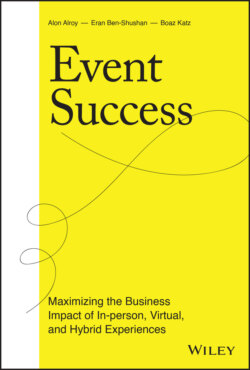Читать книгу Event Success - Alon Alroy - Страница 19
A Chorus of Aha Moments
ОглавлениеWe were an early adopter of a model that proved successful not only for ourselves, but for other major players in the live events space in the weeks and months to come. At the start of the pandemic we thought the future of our company was in jeopardy, but somewhere along the line, in the lead-up to (Almost) IN-PERSON, we experienced an “aha” moment, when all the challenges suddenly felt small, and the opportunity felt immense. As it turns out, we were far from alone in experiencing that sudden transition from a feeling of desperation to a feeling of possibility.
When the pandemic began, Colleen Bisconti was only eight weeks away from producing IBM's largest annual event, Think. Despite the sudden disruption, it was decided that the event would move forward as scheduled, but on a virtual platform. Colleen says she immediately faced a range of challenges, from technical to operational to practical, as she and her team quickly adopted a completely foreign venue format.
In order to redesign Think in a virtual format, she began by deconstructing the event. She identified the reasons people attended in the past, focusing her efforts on delivering that value in a virtual format.
“What we found was that we had way bigger reach; we had over 100,000 people actually register for this, because it was free and available to anyone, anywhere,” she says. “What that taught us was that we could extend our reach way broader than ever before, and it allowed us to reach more clients and prospective clients, more people within the accounts of our key clients.”
On the other side of the pond, Orson Francescone was facing the reality of cancelling the Financial Times (FT) Live's 200 annual global events, which typically included a small in-person crowd of a few hundred each. At the start of the pandemic, FT Live decided to host a three-day virtual event called “The Global Boardroom,” bringing together some of the world's top economists, business leaders, and lawmakers to break down the financial implications of the pandemic.
“We entered day one of the Global Boardroom with 25,000 registrations; by the end of day three we had 52,000 registrations, so basically 25,000 people registered throughout the event as the word spread,” he says. “Consumer behaviors were very different: I can register at the last minute, I don't need to book a plane ticket, I don't need to book a hotel, I don't need to book time off, so I'll decide 20 minutes before if I want to join or not join. That was kind of mind blowing. The fact that our registrations doubled during the event was pretty incredible.”
What Colleen and Orson discovered was that even with limited resources and a condensed time frame, they could still deliver value to a broad virtual audience. After that experience, neither intended to revert to an in-person-by-default mentality, even after it was safe to do so.
And they were not alone.
